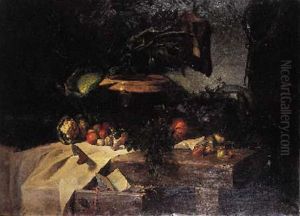Charles Marie Lhuillier Paintings
Charles Marie Lhuillier was a French artist, born in 1824 and passed away in 1898. His artistic journey is a reflection of the rich cultural milieu of 19th-century France, a period marked by rapid transformations in art, politics, and society. Lhuillier's work, primarily focusing on painting, encapsulates the transition from classical to more modern artistic expressions, embodying the nuances of Romanticism while flirting with the emerging Impressionist movement.
Lhuillier received his formal education in the arts at the École des Beaux-Arts in Paris, a prestigious institution that has nurtured countless talents. Under the guidance of renowned masters, he honed his skills, with a particular emphasis on painting and sculpture. His early works were characterized by their meticulous attention to detail and a profound respect for classical art traditions, attributes that earned him initial recognition and accolades.
Throughout his career, Lhuillier's style evolved significantly. He began to experiment with light and color, gradually moving away from the rigidity of his early works. This shift reflected the broader artistic movements of his time, as artists sought to capture the transient effects of light and the subjective experiences of the individual. Lhuillier's later works are noted for their vibrant palette and dynamic compositions, which suggest the influence of Impressionism.
Despite his considerable talent, Charles Marie Lhuillier remained relatively obscure in the annals of art history. His contributions, though significant, were often overshadowed by his more renowned contemporaries. However, recent scholarship has begun to reevaluate Lhuillier's legacy, recognizing his role in the transition between traditional and modern art forms. Today, his works are appreciated for their technical mastery and their contribution to the evolving landscape of 19th-century French art.
Lhuillier's personal life, much like that of many artists of his era, was marked by both passion for his work and the struggles inherent in the life of a creative. While specific details of his personal endeavors and challenges remain lesser-known, his artistic legacy offers insight into a deeply committed and evolving artist. Charles Marie Lhuillier died in 1898, leaving behind a body of work that continues to inspire and captivate art lovers and historians alike.








